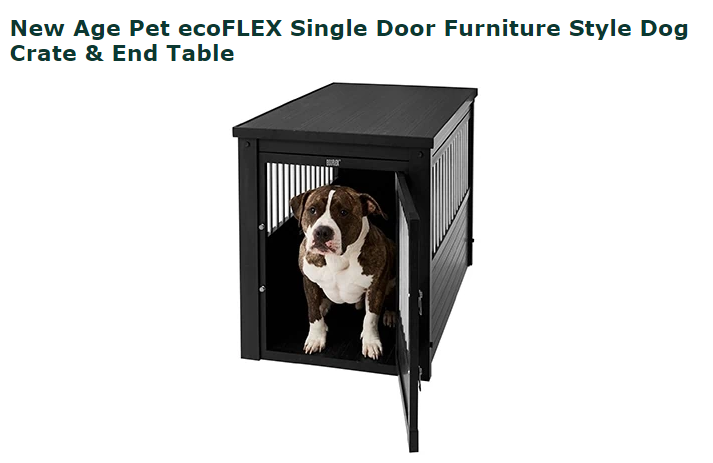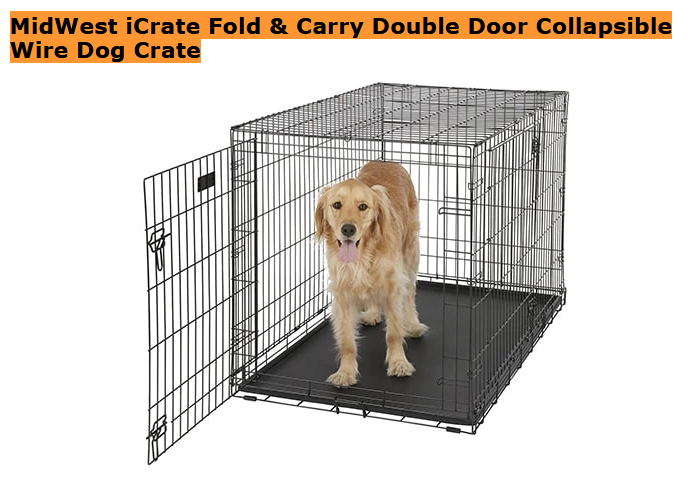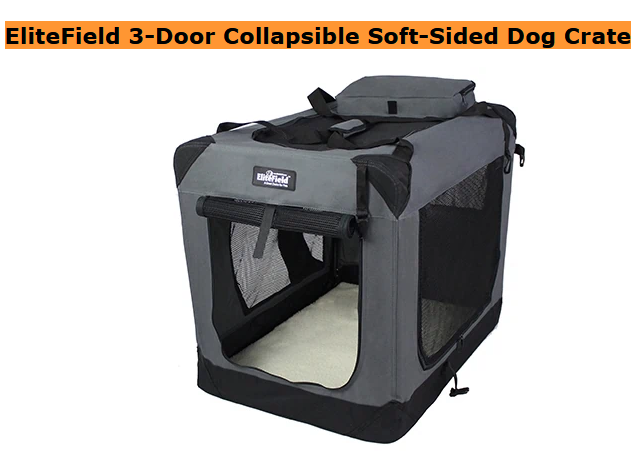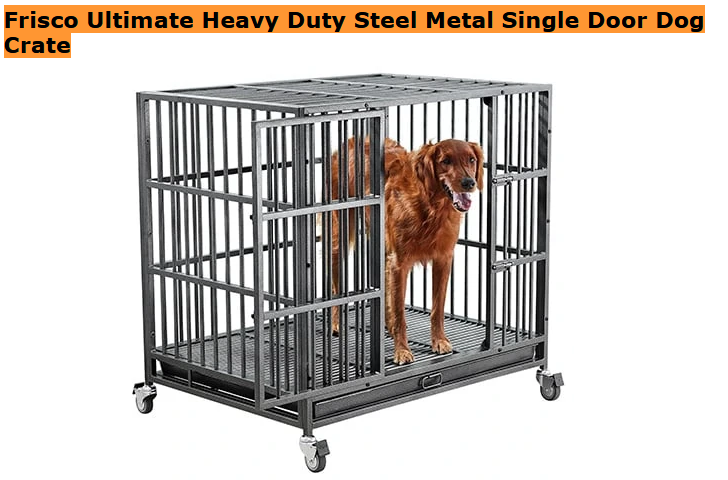High Anxiety Dog Crate | If your dog suffers from separation anxiety, you know how important it is to find the best dog crate for their needs. A high-anxiety dog crate can help your furry friend feel safe and secure when you’re away from home.
There are a variety of different types of crates on the market, so it’s important to do your research to find the one that will work best for your pet. Here are ten of the best dog crates for separation anxiety to help you get started.
The 10 Best Dog Crates for Separation Anxiety
New Age Pet ecoFLEX Single Door Furniture Style Dog Crate & End Table

The creative design eliminates the need for an unsightly metal container and blends seamlessly into any environment. Even paint it in whatever color you choose! The wood and recycled plastic structure won’t warp, fracture, or split, and it features a latching door to keep your housebroken pet secure while you’re gone. As a result, you can relax knowing that your closest buddy is safe.
You can easily wash the crate with a light detergent since it is made of ecoFLEX, a special mixture of recycled polymers and recovered wood fibers that are safe for the environment, non-toxic, and resistant to moisture and odor.
MidWest iCrate Fold & Carry Double Door Collapsible Wire Dog Crate

This crate is really easy to assemble and useful for pet owners, and it can be moved about with ease thanks to its two plastic handles. You can easily access your dog inside from the front entrance or the side door.
To make cleaning simple in the event of an accident, it comes with a sturdy, replaceable composite plastic pan, and the complimentary divider panel may be utilized while your puppy is still a youngster. Your dog is kept safe and secure within the cage by rounded edges and a sliding bolt closure.
EliteField 3-Door Collapsible Soft-Sided Dog Crate

This robust soft-sided kennel is perfect for nervous dogs since it has three zippered doors that provide easy access, ventilation, and vision without confining your dog.
Both the cover and mat are machine washable and made of sturdy, stain-resistant fabric, making it simple to clean up after an accident or just to simply refresh the fabrics anytime you wish.
With lightweight steel tubing and a mesh and polyester fabric that is simple to clean, this device assembles quickly and folds just as quickly. Along with a fleece bed, it also comes with a complimentary carrying bag, making it ideal for traveling with your dog.
Carlson Pet Products 36-in Extra Tall Dog Gate

Some fearful puppies fare better outside rather than confined in a kennel. The Carlson Extra Tall Gate is the best option if your dog exhibits this behavior. Your dog can see across rooms because of the open layout, which prevents them from feeling excluded.
This gate is a solid and safe solution for dogs that need additional room. It will look magnificent in your house and fit most entrances, making it perfect for both little and big breeds. It is made of New Zealand wood.
It may be wall-mounted with tension rods and used to secure hazardous places like staircases. The lever-style handle has a one-touch release safety lock that makes it simple to get in and out. Even a smaller door for more dogs is included!
Frisco Ultimate Heavy Duty Steel Metal Single Door Dog Crate

This premium cage is built of 22-gauge steel with 1/2-inch steel tubing, unlike plastic or wire kennels which may not be good for dogs that are prone to escape. The crate is sturdy and substantial yet simple to use, and it has two locks on the door that are out of reach so your dog can’t tamper with them. It can withstand dogs who chew, dig or exert a lot of weight.
You can simply move it around and lock it securely since it has wheels with foot brakes. It is an excellent cage for everyday use and suited for most breeds since it has powder-coated steel and welded stress areas, which resist scratches, dents, and corrosion. Food and trash fall through a grate on the floor, and cleaning is fast and simple thanks to a slide-out tray beneath. The hammer-tone finish also complements any decor well!
6 Tips for Choosing the Best High Anxiety Dog Crate
The following are the key features to consider while selecting a high anxiety dog crate:
1. Durability:
A good high anxiety container should be constructed of durable material, ideally metal or, especially, reinforced steel. When the anxiousness sets in, a big dog may easily gnaw and rip through a weak wire kennel.
2. The Crate Size:
it shouldn’t be too little or too large. Small crates are unpleasant, while overly large crates might make your dog more anxious. You may buy a huge crate and use a partition to make the inside smaller if you have a tiny puppy that is still developing.
3. Chewproof Material:
It’s important to choose a sturdy material that can withstand a dog’s teeth since anxious dogs are noted chewers. A stylish wooden box may not be the best option for a nervous dog.
4. Maintenance:
Pick a box that will be simple for you to maintain. This necessitates that it be simple to maintain, fix, and get replacement components for. Since stressed dogs are more likely to have pee and feces accidents, it is always great to have a detachable tray at the bottom.
5. Closed Structure:
It should go without saying that you shouldn’t choose an open crate if you want to simulate the cave-like sensation with a crate. Locate a crate with just enough ventilation to provide circulation and just enough seclusion for your dog to feel at ease.
6. Brand:
Lastly, consider the credibility of the brand. A trustworthy company will often show testimonials from prior clients. Additionally, it will provide warranties and money-back guarantees.
The Benefits of Using a High Anxiety Dog Crate
Whether you own a dog that suffers from separation anxiety or you’re simply concerned about your pet’s behavior, it’s important to understand the benefits of using a high anxiety dog crate.
Here are some of the most common reasons why many people choose to use a high anxiety dog crate:
1. Helps prevent accidents
Leaving your dog in a crate prevents them from having accidents and helps prevent unwanted fur buildup. They can’t get out to mark their territory and they won’t be bothering your home while you’re away.
2. Reduces destructive behavior
When your dog is crated, they have less to focus on. Consequently, they are less likely to engage in destructive behavior such as chewing or digging.
3. Helps control exercise
If you’re like most pet owners, you likely walk your dog at least twice a day for at least half an hour at a time. In order to be able to do that and not have to worry about them tearing up your yard, you will need to house them during their times of confinement.
4. Reduces loneliness
When confined, many dogs develop anxiety and depression. Crating can help ease some of that tension by providing a sense of security and privacy.
5. Prevents separation anxiety
Dogs with separation anxiety will often times howl or cry when they are left alone. Leaving them in a crate while you’re away prevents your dog from developing this issue.
The Cons of Using a High Anxiety Dog Crate
It’s important to consider the potential cons of using a high anxiety dog crate, as well as the risks involved. Here are a few things to keep in mind:
1. Destructiveness
It’s important to keep in mind that most dogs are only destructive because they’re bored. Dogs that are confined in a crate for long periods of time will begin to show signs of boredom, which is when they will start chewing on their crates or other objects.
2. Less exercise
Since a dog can’t run around as much while confined, it will require more exercise to compensate. This usually means longer walks and runs, which will require more time and effort from you.
3. Noise
Many dogs dislike being confined. If your dog has a tendency to be anxious, he may begin to whine or bark. If this becomes too much for you, then consider investing in a pet mask that will help block out the noise and provide some peace of mind.
4. Injury
If your dog has a history of escaping or chewing on things, then a high anxiety dog crate may be too much for him. In this case, you may need to look into professional training that can help him break the habit.
5. Boredom
Some dogs will start chewing on their crates when they are left alone in them for too long. Chewing is often a way for dogs to relieve stress, but it can easily lead to broken bones and costly injuries. Fortunately, there are plenty of products available that will keep your dog occupied while confined in his crate.
How to Use a High Anxiety Dog Crate
Now that you know the benefits and potential cons of using a high anxiety dog crate, it’s time to learn how to use one safely. There are a few rules to follow:
- Never leave your dog unattended in his crate. This is a major red flag that something isn’t right. Your dog may have been abused or neglected before being put into your care, so it’s up to you to make sure nothing like that happens again.
- Dogs don’t need to be crated for long periods of time. For example, if you’ve gone for only a few hours and there’s no reason to believe your dog will be in his crate for more than 4-5 hours total, you don’t need to crate him. Try leaving him in an area of the house where he feels comfortable and safe. If he becomes anxious, leave and come back later. This is normal behavior for dogs and shouldn’t be cause for concern.
- Dogs don’t need to eliminate in their crates. Some dogs may have accidents in their crates, especially when they are first introduced to it. If you aren’t sure if your dog is eliminating in his crate, then here’s a guide to helping you determine that.
- Make sure your dog is healthy enough to go into a crate before trying. If your dog has any health issues, then it’s important to consult with your vet before using a crate.
- Set realistic expectations for how long your dog will be able to stay in his crate. Even the most obedient dog will have an accident or two in their crate. Like anything, this will take some trial and error to get it right.
How to Teach Your Dog to Stay in His Crate

It’s important to remember that crating your dog is a way of training them. Like any other behavior, you have to start out by teaching your dog what’s expected of them before you can expect them to actually follow through with it. You’ll also want to continue practicing the behavior outside of the crate. Here are a few things to keep in mind:
- Use a positive method of reward whenever possible. Using a clicker and treats are both effective ways of rewarding your dog when they do what you want them to do in their crate.
- Make sure the crate is big enough for your dog to be comfortable. If they are not able to stand, turn around, and lie down comfortably, then it will be difficult for them to remain in their crate.
- Always put your dog in the crate when they are calm. If you rush them into the crate while they are scared or excited, they may end up panicking and never want to go back inside.
- Use a crate mat or blankets if your dog will be spending a lot of time in their crate. This will help to keep them comfortable and reduce the chance of them tracking in dirt or other debris from the outside world.
- If your dog is crated for too long, then you may need to work up to longer periods of time. Start by crating your dog for just a few minutes at a time. Over the course of a few days, increase that to 30 minutes, 1 hour, and so on until you are able to leave them in their crate for longer periods of time.
- Always bring your dog into your bedroom with you when you are first starting to crate train them. This will help them get used to being in the room with you.
Watch the tutorial
Conclusion: High Anxiety Dog Crate
Not all dogs will respond to being crated in the same way. Some dogs may take a little longer than others to warm up to their crate. Be patient and don’t get discouraged if it doesn’t happen right away. Like any other behavior, you’ll want to work your way up to longer periods of time and make sure that your dog is healthy enough to withstand being crated for that amount of time.
Further Reading:
Cat Paw X ray – See Inside Your Cat’s Paws Without Surgery
Rottweiler: Every Information You Need to Know About This Dog
Rhodesian Ridgeback: The Lion Fighter
1000 Interesting Dog Names and their Meaning
Cane Corso: Every Information About This Breed
Golden Retriever: Everything You Need To Know About This Breed
Can Dogs Eat Bread? Read This Before Feeding It To Them
Can Dog Eat Pineapple? Pineapple, the Fruit vs Pineapple, the Treat
Can Dog Have Beef Jerky? The Truth About This Healthy Snack
Can Dog Have Broccoli? – Everything You Need to Know
Can Dogs Eat Eggplant? The Truth, Explained
Can Dog Eat Eggs – Everything You Need to Know About Eggs and Your Dog
How Long Can a Dog Go Without Food
Can Dogs Eat Pork – 10 Things You Should Know